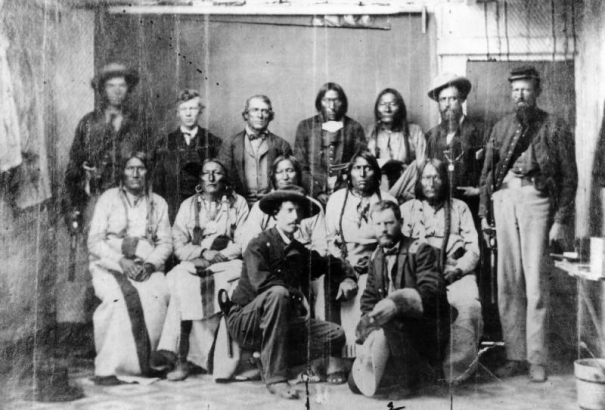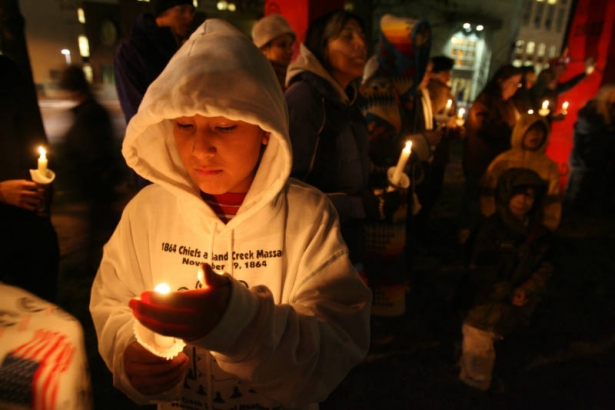[Warning: Quotes in this article include derogatory language, in accordance with the racism of the time and the original writers.]
William N. Byers has been celebrated as one of Denver’s earliest and more vociferous boosters. He ran Denver’s first newspaper, the Rocky Mountain News, from 1859 to 1878 and served as its first owner and editor during that period. His promotion of the area’s agricultural and economic benefits, some of which were questionable or downright lies, helped enrich the city, state, and Byers himself. However, as they say, with great power comes great responsibility, and Byers used his power in ways that caused harm to many of Colorado’s residents of color, particularly local Cheyenne and Arapaho people.
Byers’s greatest harm was centered around the Sand Creek massacre in late 1864. A strong supporter of Governor John Evans, Byers helped to promote the concept of an “Indian War” being waged at that time and further perpetuated this myth in his 1901 volume, Encyclopedia of Biography of Colorado. Indeed, violence was perpetrated by Native Americans and white settlers, but to call it a full-scale war was excessive by most standards. Through 1864, the Rocky Mountain News was full of “Indian raids,” reports of those killed by Native American attackers, and a barely averted plan to massacre settlers to the south and all along the Platte (Aug. 26, 1864). White panic flourished when the Hungate family was murdered and mutilated just outside of Denver in June. The rhetoric of newspapers in the region, including the Rocky Mountain News, only served to further excuse violence against all nearby Native Americans, as would be seen.
In August, the Rocky Mountain News published an appeal by Governor Evans to establish civilian militias to fight “the merciless savages.” To back that up, the News published its own editorial, written or at least approved by Byers, that encouraged citizens to join. The editorial declared, “A few months of active extermination against the red devils will bring quiet, and nothing else will.” (Aug. 10, 1864). Three days later, they again published an appeal from the Governor, this one specifically for volunteers to join the Third Regiment. On October 5, the Rocky Mountain News published under the headline “Good News for the Third Regiment,” a message from Colonel Chivington that “The boys of the Third may soon be off on the war path [sic]. Let the red skins [sic] look out now.”
Controversies over blame and cruelty surround the history of the Sand Creek Massacre. Regardless, on November 29, 1864, First and Third Regiment cavalry attacked the village of Cheyenne and Arapaho people under the leadership of Black Kettle, a Cheyenne chief trying to maintain peace. There are accounts that Black Kettle was waving an American flag and/or a white flag at the time of the attack. In spite of all indications that the village was peaceful, US troops killed approximately 200 of the men, women, and children as they tried to flee. The volunteers then mutilated their corpses and took gruesome trophies of their kills.
In the aftermath of the Sand Creek Massacre on November 29, 1864, the Rocky Mountain News trumpeted it as a “Great Battle with Indians,” and celebrated the deaths of Native Americans (Dec. 14, 1864). Even after multiple federal jurisdictions investigated the incident and declared Sand Creek a “foul and dastardly massacre,” Byers’s paper continued to stand by Chivington and Governor Evans, endorsing and publishing their counter-arguments and endorsing the “Sand Creek Vindication Ticket” that November.
Byers continued to endorse this false narrative of Sand Creek years later. An 1870 column expressly written by the News’s editor--Byers--argued that “our soldiers should not be blamed for killing women and children in their onslaughts upon Indian camps.” As an example, he described, “at Sand Creek our men were wounded and killed by arrows shot by tender aged boys--and, Heaven save the mark--tender squaws” (RMN Apr. 13, 1870). He had not changed his story by 1901, again claiming that the investigations were intentionally biased against Chivington and “ignored all testimony as to the immediate culpability of the Indians slaughtered, as revealed by the numerous scalps and piles of plunder found in their possession” (Encyclopedia of Biography of Colorado).
While Byers’s words may seem less significant as we now acknowledge the horror of the Sand Creek massacre, it is worth noting several specific elements of harm that his words did. In contributing to an environment that would allow for such a massacre, Byers contributed to the generational trauma experienced by the massacre’s survivors and their descendants. By denying the reality of what happened, he continued to twist that knife and contributed to the cover-up of indigenous memory for ensuing generations.

![[William N. Byers] [art original].](/sites/history/files/styles/blog_image/public/cdm_85720.jpg?itok=6FAV8zVv)


Comments
In 1991 I went to the branch
In 1991 I went to the branch named for Byers, after spending my youth reading the books there. I explained to the librarian who worked there, the facts that I had just recently learned about this massacre and Byers, after checking out and reading every book the downtown library had on this event. I am more than elated that the time has finally come to right a long time wrong. We’ve too long made heroes out of liars.
Thank you for reading and
Thank you for reading and sharing, Martha. We are pretty hopeful about this change too.
Isn't sensationalism in the
Isn't sensationalism in the media still present as an attempt to attract more attention from the public? Did anyone try to count how many families, ranches, travelers, stage coaches etc. had been preyed upon by young braves out to make a name for themselves, count coup, or steal horses etc? Native tribes warred with each other in this fashion, why would the Americans from the East be treated any differently? Tribes also secured territory for themselves this way and "hunting grounds", no? Part of the difference between the American settlers and the tribes people was the tribes acceptance of their type of warfare consisting mainly of hostile raids by perhaps independently acting young men, while the Americans found such raids especially where their livelihood or their families were attacked to be just as Byer's paper no doubt declared, "Savage". I don't think Byers created that attitude,I think he milked it! The clash of cultures fed significantly into what caused Sand Creek, and interestingly enough, Custer created a similar massacre at the Washita in 1868, which we do not hear much about either. I do believe that many of those tribesmen at the Little Bighorn were well aware of what Custer had done years earlier, and that Custer likely met with a kind of justice at that place.
Thanks for reading and
Thanks for reading and engaging with the article. Sensationalism is certainly a part of news media throughout history. The Rocky Mountain News regularly published notices of attacks by Native Americans on settlers, which was part of inflaming Coloradans and creating an environment in which massacres of Native Americans would be likely and considered acceptable. We would not argue that Byers orchestrated the massacre, but his being more interested in readership than human lives and denying loss after the fact did clear harm. Settler Colonialism is a complicated and bloody reality in the history of the American West, but it's also clear that "Americans from the East" were the main perpetrators of that bloodshed.
It seems to me, fear played a
It seems to me, fear played a major part in the day and life of Pioneers. Bloody savage acts were performed by the Indians, as well as the Pioneers. I read that Byer's referred to the Confederates as "Savages" too. What acts did Byers see to make him write this? Are any cultures pristine? Why was the library named after Byers to begin with?
Do we need to hide history by changing the names of buildings trying to forget the past or teach our children to embrace the good and bad and learn from the past? I am not justifying William N. Byers, but it seems to me people today have no idea what life was like in the 1800's.
Thank you for reading and
Thank you for reading and commenting, JT. Byers was involved in much of the early history of Denver, from starting the city's first newspaper to boosterism. You can learn more about that in many of his biographies, such as the one on Colorado Encyclopedia. His prominence at the time would have likely led to his name on the branch. However, times change and historical figures are complicated. Chivington was an outspoken abolitionist who also orchestrated the murder of Native people. This is why it's necessary constantly reassess our views of historical figures.
We also now know that there
We also now know that there were many times when Anglos dressed as Indians and perpetrated raids that would be blamed on Indians. There was a case of this in Utah which resulted in an official apology.
Thank you for such a great aritcle! Its sad that it has taken this long to become a real conversation, and I appreciate your offering on this.
Thank you for reading and
Thank you for reading and commenting, Bobbie. It's a tragic part of our history, but one we must face.
Hopefully they will have some
Hopefully they will have some plaque showing the former name and worthy accomplishments of Mr. Byers. Just like every single person on this planet we are all flawed. It doesn’t matter what name the library picks as long as we are not being revisionists and erasing the past.
Thank you for reading and
Thank you for reading and commenting. Rectifying the future should not erase the past.
Add new comment